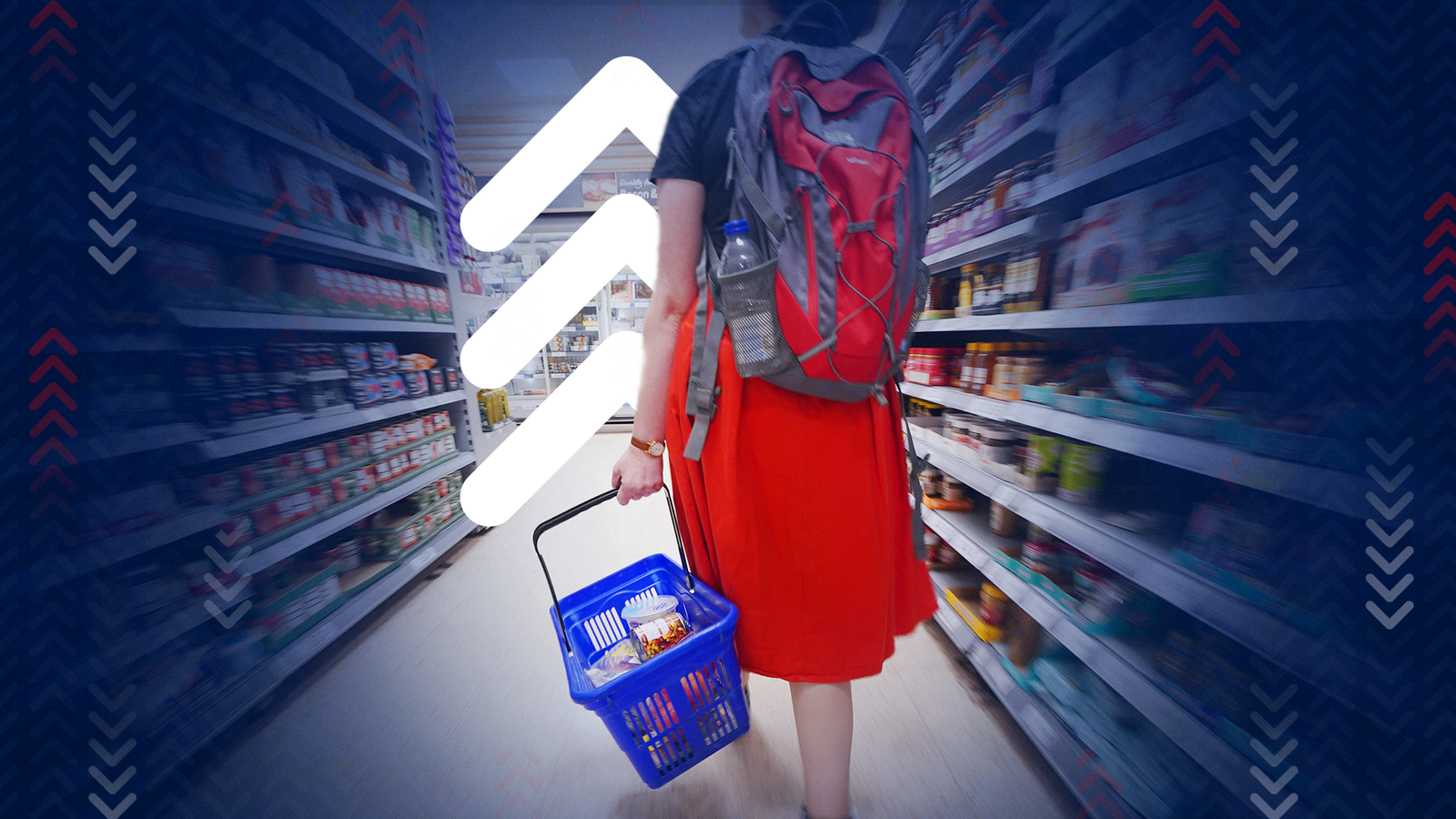Food prices rose 19.3% in the year to April, despite the costs of key inputs such as energy and grains continuing to fall.
The war in Ukraine, the effect of lockdowns and other supply chain pressures saw energy, fertiliser and grain prices rise significantly last year.
But as some of those pressures start to ease, supermarkets and producers are facing questions about why consumers are still seeing the cost of their weekly shop rise.
Dairy products such as milk and cheese have been some of the worst-hit food items, with prices rising by 30% in the year to April.
One reason why retailers are continuing to raise food prices could be that many will be seeking to make up for a fall in margins last year, when they were slow to raise checkout prices.
Between May and August 2022, the chart below shows, retailers of dairy products saw their costs rise rapidly. The prices they charged to consumers also rose, but much more slowly.
By adding up the difference in retailer costs and prices in the months since January 2022, we can see whether retailers have made up for this fall in margins.
The chart below shows the cumulative effect of retailers’ margins (the difference between how much retailers pay for dairy products and how much they charge consumers) since January 2022.
For simplicity, we’ve assumed that consumers buy the same quantity of dairy products each month.
This is a rough estimate, but it does suggest that retailers have finally increased their margins on dairy products enough to have made up for the shrinking of margins last year.
This won’t be true of all retailers – our data is for the retail sector as a whole – but it does raise questions about the causes of additional price increases.
Please use Chrome browser for a more accessible video player
Richard Lim, CEO of Retail Economics, told Sky News there are many factors feeding into food inflation, of which the price of the actual products for sale is just one element.
High street retailers face significant operating costs, such as wages and utilities, which have also been increasing.
“A lot of those costs have begun to ease, but at different times and to different levels, depending on lots of factors,” says Lim.
“For fresh produce in the grocery sector it is a much shorter supply chain and things happen a lot faster. For things like tinned foods and dried products it happens at a slower rate.
“A lot of the grocers will have contracts with their manufacturers and those prices are agreed over a period of time. Contracts are rolling and get renewed continuously throughout the year. So hence you have that lag in prices as it goes through the supply chain.
“We’ve seen an easing of commodity markets, of factory gate prices and of some other areas of operating costs. It does take time to feed through. But we’d expect them to moderate over the summer and towards the end of the year.”
Who’s making money?
The Liberal Democrats and the trade union Unite have called on the Competition and Markets Authority to launch an investigation into whether supermarket price rises are a form of profiteering.
Kris Hamer, director of insight at the British Retail Consortium, told Sky News: “If you look at the financial results of any of the big food retailers, the margins that they’re making are pretty slim. Some of our members are announcing underlying losses, from running their operations.
“So just looking at the numbers, you can see that there’s not profiteering going on. I think the question that perhaps politicians ought to be asking is where is the money?
“If you look through the supply chain, who’s making money from the point of purchase from the farmer’s field through to the [retailers]? The margins are not made in the last mile.”
The two biggest supermarket chains, Tesco and Sainsbury’s, both reported a decrease in pre-tax profits in the year to March.
Tesco’s profits were down by more than half compared to the previous year, while Sainsbury’s were down by 5.5%.
By contrast, one of the major suppliers of goods to supermarkets, Unilever, saw its pre-tax profits rise 21% in 2022. We asked Unilever for comment and are awaiting a response.
The Competition and Markets Authority said recently that they have “not seen evidence pointing to specific competition concerns in the grocery sector” but are stepping up work in the sector “to be sure that weak competition is not adding to the problems”. This includes looking at suppliers as well as supermarkets.
How are the producers faring?
Prices at the producer end (received by farmers for their produce) has been falling in recent months. For dairy products, the peak of producer output prices was in November 2022.
This poses some challenges for businesses still facing cost pressures.
Harry Pinsent is the owner of Higher Ludbrook Farm, a dairy farm in South Devon. He manages a team of three full-time employees milking 330 Jersey-Friesian cows.
Please use Chrome browser for a more accessible video player
The business has faced extensive challenges around the cost of feed, fertiliser, and fuel. Last year, they all shot up.
While some costs are starting to come down, farmers are often tied into longer-term contracts for utilities and fertiliser.
Mr Pinsent explained: “The problem with so much of farming is it’s such a delayed effect. We bought fertiliser last year for this year, and we’re having to cover that cost from last year now.”
Read more:
Significant easing of inflation as energy costs stabilise
UK economy – latest: Interest rates will now rise again
Some good news, but the inflation figures will deeply worry economists
There is also a lag effect for those tied into electricity contracts at peak prices for 12 months into the future.
Then there are the other price increases which have no prospect of coming back down, including increased wages for farm workers, who are facing their own cost of living challenges.
On top of that, some income is now falling too, with supermarkets now paying less for the farm’s milk.
Will food prices actually come down again?
While food inflation is expected to come down in the coming months, this doesn’t mean that prices will start falling.
Any amount of inflation means that prices are rising. Lower inflation just means that they are rising at a slower rate.
Kris Hamer, of the British Retail Consortium, says meaningful price decreases for consumers may be some way off: “What matters to consumers is that they feel better off, and we don’t think that prices are going to fall significantly this year.
“On the cost of goods side of things, there’s reason to be hopeful that product prices will come down realistically in the first half of next year.”
You can find more information on the price of specific items in your shopping basket using Sky’s spending calculator here.
The Data and Forensics team is a multi-skilled unit dedicated to providing transparent journalism from Sky News. We gather, analyse and visualise data to tell data-driven stories. We combine traditional reporting skills with advanced analysis of satellite images, social media and other open source information. Through multimedia storytelling we aim to better explain the world while also showing how our journalism is done.








